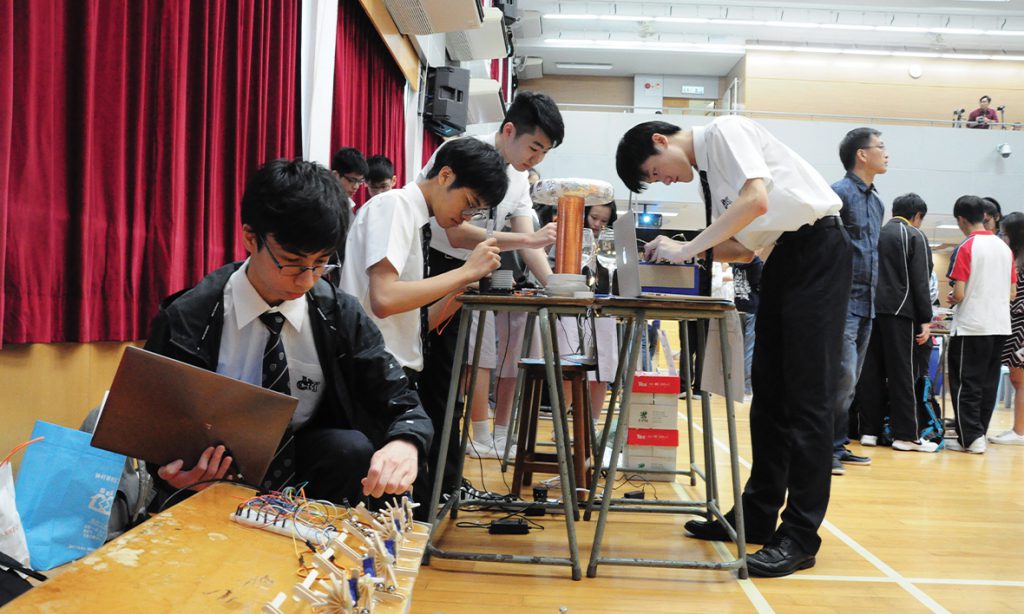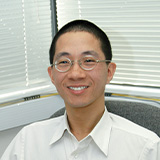November 2019 | Volume 21 No. 1
Turning STEM into STEAM through Music
The primary objective of the ‘STEAM’ competition, organised by the Faculty of Engineering and the Arts & Technology Education Centre (ATEC) and supported by the Knowledge Exchange Fund, was to enhance interest in and knowledge of how to engineer musical instruments to encourage creativity and expression in youngsters.
Entitled ‘The Science and Engineering of Sound and Music’, the competition was organised by Dr Ivy Wong Ka-yan and Dr Beta Yip Chi-lap and attracted more than 400 participants from primary, secondary and international schools across Hong Kong.
Teams were required to design and build a device capable of producing sound and being used as a musical instrument, culminating in a live performance and competition to decide the most innovative and attractive.
Dr Wong said: “We wanted to engage youngsters by cultivating their interest and curiosity through hands-on and minds-on activities to solve problems in their daily lives. Auditory and verbal communications through sound, rhythm and music are basic in human lives. With the increased availability of low-cost, easily programmable hardware, open-source software and easy modelling and creation of 3D objects, students can build their own musical instruments when given suitable guidance.”
“It was multidisciplinary,” added Dr Yip. “The aim was to teach them science about sound and music, engineering principles, 3D modelling and programming techniques for creating their musical instruments.”
The Engineering Faculty team, led by Professor Francis CM Lau, has been working on collaborative knowledge exchange projects since 2006, giving them much experience in promoting STEM education to primary and secondary school students. Other projects coordinated by Dr Wong and Dr Yip include a number of competitions for school teams to design and implement effective methods or devices for meteorological instrumentation, such as measuring visibility, ultraviolet radiation and sea level and detecting the existence of lightning and earthquake, which were jointly run with the Hong Kong Observatory and the Hong Kong Meteorological Society.
For the musical instruments competition they coordinated a series of workshops and talks running over four months to give participants knowledge and ideas on how to go about their task.
“We taught the students programming, circuit design, 3D printing and laser cutting to show them what can be done using simple tools,” said Dr Yip. “We also invited professional musicians to share their experience on topics such as ‘What is music?’, challenging students to expand their thinking and learn it’s not necessarily all about do-re-me. This gave them more scope when developing their own musical instruments.”
Asked what made them come up with the seemingly unlikely pairing of engineering and musical instruments, Dr Wong said: “Art and technology have always been closely related in that craftsmen must be at the top of their game when making musical instruments.
“The project coordinator and the team applied computational technology in arts, in particular music, for applications such as automatic music accompaniment, selection of melody lines, indexing of musical features, and the creation of mobile keyboard instruments. It was all part of putting the ‘A’ into STEM.”
Musical hit or miss?
And were the instruments actually musical? Dr Yip replied in the affirmative, saying that some of them could play a tune, and more: “During the concert, it was evident that the students spent a lot of time and effort preparing their performances and did their best to demonstrate their work to its best advantage.”
While some teams had built familiar-looking instruments such as variations on pianos or drums, others had worked hard to incorporate innovative elements such as stepper motors, spinning wheels, marbles, wine glasses and wooden boxes to generate an original sound. Some even composed their own music and performed it on stage.
This was the team’s first collaboration with the Arts & Technology Education Centre, a government education centre for STEM and arts education and they hoped to provide knowledge exchange not only for the participating teams through the proposed competition, but also for teachers who will train future students afterwards.
For the future, Dr Wong would like to see more funding opportunities to enable them to organise more knowledge exchange projects, which she feels have value not only in themselves but can generate useful outcomes too. “The associated lectures, workshops and demonstration materials of the knowledge exchange projects could become effective teaching and learning resources and be useful for lifelong learning activities for schools and the general public,” she said.

The champion of the secondary school category goes to Team Mackerel from the Po Leung Kuk Choi Kai Yau School.

A guest playing the handcrafted plucked-string instrument that was inspired by Chinese musical instrument Yangqin.
We also invited professional musicians to share their experience on topics such as ‘What is music?’, challenging students to expand their thinking and learn it’s not necessarily all about do-re-me.

DR BETA YIP CHI-LAP

